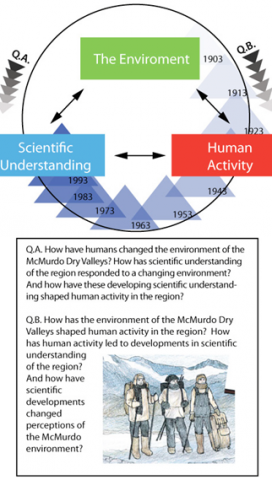

Overview: Integrating Science and Society. In 1903, Captain Scott and his two companions became the first humans ever to see the McMurdo Dry Valleys in East Antarctica. Since then, relatively few people have ever visited the region, and the majority of these visitors have been involved in scientific activity. This project uses environmental history to examine the interactions between human activity, scientific research, and environmental change in this unique region over the past 100 years. In much the same way as the simplicity of the MDV ecosystems makes the area an ideal location for formulating ecological theory, the reductionism of the area's human history - in terms of its short timeframe and the small number of people involved - makes it an excellent location for integrating the theory and practice of environmental history with the ecological research of the LTER network. It is arguably easier, for example, to trace historical interconnections between science, policy, and environmental change in the MDV than at other sites with more complex human-environment coupling (Figure 1). The first stage of this project has involved research into the earlier human history of this region (below). Future research will continue to trace the history of the Dry Valleys up to the present through archival research and oral history interviews, with a particular focus on the interaction between environmental change and scientific developments over time. Stage One: Taylor's Valley The first stage of this research has been to examine the earliest human history of the McMurdo Dry Valleys during the so-called "heroic era" of Antarctic exploration at the beginning of the twentieth century. In February 1911, the Australian geologist Griffith Taylor (Figure 2) led the first significant scientific expedition into what would become known as Taylor Valley along with Frank Debenham, Charles Wright, and Edgar Evans. The party spent a week exploring the valley, and their observations provide valuable information about what the environmental conditions in the area one hundred years ago. For example, Taylor sketched and described the location of glaciers, the width of melt-water streams, and the size of the frozen lakes in the valley. These descriptions can help to provide an important baseline for thinking about environmental change in the region over the past century. The initial research also provided a salient warning that historical sources such as Taylor's papers need to be treated with some caution. Taylor's published map of the valley (Figure 3) completely fails to include Lake Fryxell, one of the important locations for LTER research. Such an omission initially suggested the possibility that the lake was not present when Taylor walked through the valley. However, further research has revealed that the lake was present, and that its omission from Taylor's published map was the result of human error. Nevertheless, used carefully, this early expedition has contains much information that contribute to the scientific work of the McMurdo Dry Valleys LTER site. It is possible, for example, that Lake Fryxell may have been smaller in 1911 than it is today, which would be consistent with broader trends of rising lake levels in other parts of the valley over this period.
See this work at http://mcmurdohistory.lternet.edu
